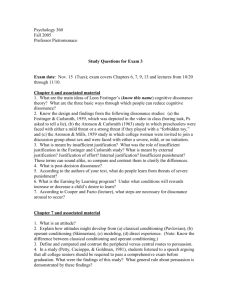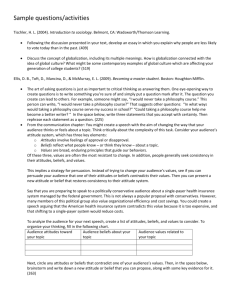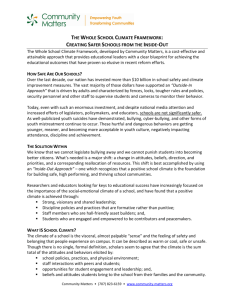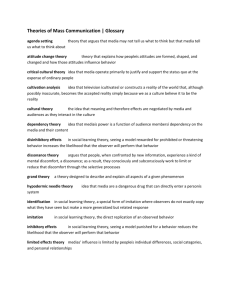Beliefs and Attitudes Today Beliefs Beliefs Beliefs Beliefs
advertisement
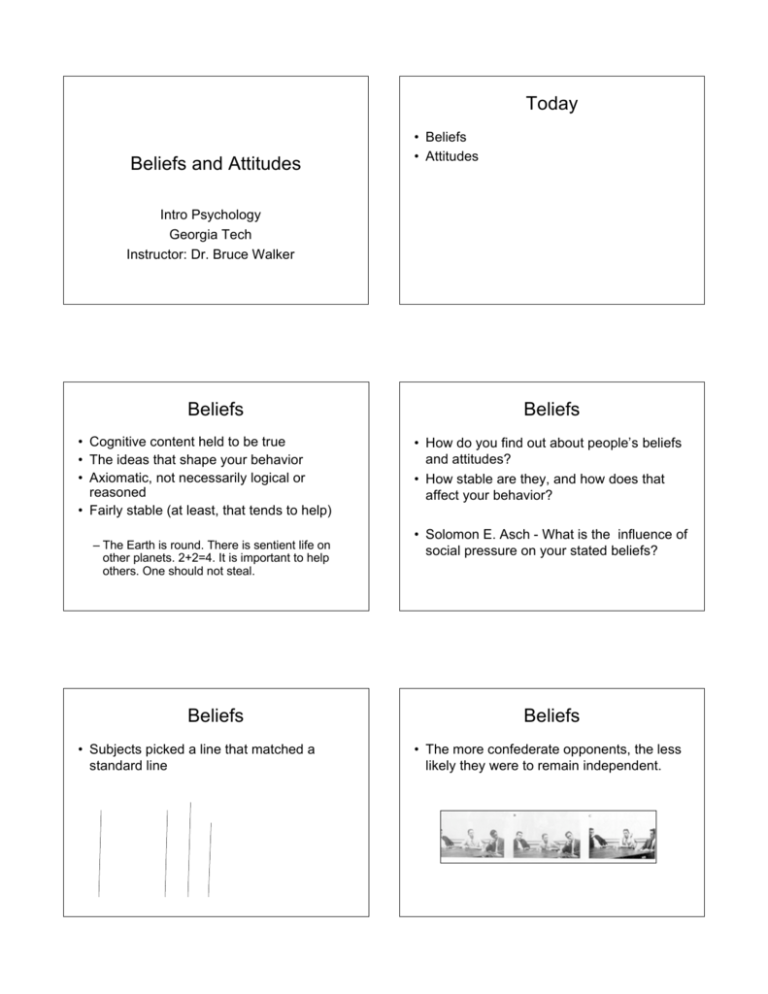
Today Beliefs and Attitudes • Beliefs • Attitudes Intro Psychology Georgia Tech Instructor: Dr. Bruce Walker Beliefs • Cognitive content held to be true • The ideas that shape your behavior • Axiomatic, not necessarily logical or reasoned • Fairly stable (at least, that tends to help) – The Earth is round. There is sentient life on other planets. 2+2=4. It is important to help others. One should not steal. Beliefs • Subjects picked a line that matched a standard line Beliefs • How do you find out about people’s beliefs and attitudes? • How stable are they, and how does that affect your behavior? • Solomon E. Asch - What is the influence of social pressure on your stated beliefs? Beliefs • The more confederate opponents, the less likely they were to remain independent. Beliefs • Subjects did not “believe” that the line was the correct one but were afraid to go against the group. Attitudes and attitude change • Attitudes are a fairly stable evaluative disposition that makes a person think, feel, or behave either positively or negatively toward some concept, person, group, or social issue. • Problem - our attitudes are not always well worked out. Where do attitudes come from? • Behaviorally based – Attitudes that seem based more on an inference about one’s own behavior. – Most interesting! • Festinger and Cognitive Dissonance Beliefs • As task gets more difficult (harder to pick a line), social influence increases (Suls & Miller, 1977) Where do attitudes come from? • Cognitively based – Classification of attitude “object” based on evaluation of information available. – Relatively dispassionate, open to give and take • Affectively based – Based more on emotions than objective information – Difficult to change – topics banned from dinner table. How Strong are Our Beliefs and Attitudes? • Do we hold our beliefs? • Do our attitudes change? • If so, what can affect our attitudes and beliefs? Festinger’s Dissonance • People prefer consistency between their attitudes and their actions. – “I’m basically a good person” • Inconsistency between attitudes and actions results in dissonance that is unpleasant – Change behavior, or… – Bring attitude in line with behavior Brehm’s distortion of likes and dislikes Brehm’s distortion of likes and dislikes • Posed as a representative of consumer testing service • Asked women to rate the attractiveness and desirability of household appliances (it’s the 1950’s) • As reward, women given a choice between two items identically rated in attractiveness and desirability. Justification of great effort • 20 minutes later, women were asked to rerate all the products • Effort is • Selected appliance was now slightly more attractive than before • Other appliances were much less attractive than before (!) • Aronson & Mills (1959) Justification of great effort • Aronson & Mills (1959) – After “passing” test, listen to sample of discussion group • “Mumbling, confused, one of the most worthless and uninteresting discussions imaginable…” – Now rate how interesting the discussion was – Predictions? – Consonant with positive outcomes – Dissonant with aversive outcomes – Women in a discussion group; must pass screening test • Averse test: reading “taboo” words aloud to experimenter • Mild test: reading ordinary word list Justification of great effort • Aronson & Mills (1959) – Mean ratings of interest (out of a 100) • Control group (no screening) – 80 • Mild screening – 82 • Severe (“taboo” words) screening - 96 Justification of great effort • With increasing effort (i.e., to get into the group/club), the value of the goal (i.e., being in the group/club) tends to increase. – Many many many examples – Boot camp, frat hazing Forced compliance • Festinger & Carlsmith (1959) – Subjects then asked by experimenters to rate how much they really enjoyed the tasks – $20 paid subjects – boring, boring, boring. – $1 paid subjects – not so bad, could have been worse, even a little interesting. Hmmm, forbidden donut… • Aronson & Carlsmith (1963) – What happened? Forced compliance • Festinger & Carlsmith (1959) – Stanford students spent an hour performing excruciatingly boring and repetitive tasks. – At end of experiment, students told to convince the next subject (i.e., lie) that the experiment that they would be in will be extremely interesting and enjoyable. – Half of these lying subjects given $1, half given $20. Hmmm, forbidden donut… • Aronson & Carlsmith (1963) – Children asked about a set of toys, which ones did they really like, which ones were yucky. – Experimenter picked toy especially liked by child – Experimenter left room telling half of the children that they would be punished severely if they played with the toy, half were told they would be given a mild punishment. Hmmm, forbidden donut… • Aronson & Carlsmith (1963) – Desirability of toy in severe punishment condition went up. – … in mild punishment condition, it went down. Results from Dissonance studies Self knowledge? • Desire for consistency can lead to changes in attitudes or behavior • Paradoxically, meager rewards and punishments may have larger effects in some cases. • We do know ourselves, but we also seem to have a different, idealized “knowledge” Self knowledge? • Nisbett & Wilson (1977) – Hearing stories with and without noise – Diary studies of mood and causes of moods – Judgments of clothing quality and order effects Upcoming • • • • Emotions Social Context Psychopathology Final Exam – “What would you really do if…?” • Dissonance studies suggest less accurate self knowledge than we think – Mismatch between behavior and beliefs/attitudes can change either behavior or attitude – Underlying cause for the change is typically not easily identified (and change is rarely noted) – Recall Schacter and Singer? Inferences about others, inferences about ourselves • We seem to have limited insights into actual causes of our decisions, attitudes, and behaviors • Inferences about causes of our own behavior may be similar to inferences about others • Bulk of “thinking” seems to go on below level of actual awareness.




